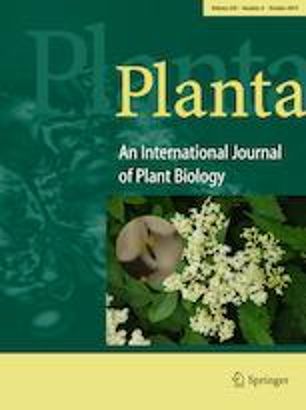Ver ítem
- xmlui.general.dspace_homeCentros Regionales y EEAsCentro Regional Mendoza - San JuanEEA La ConsultaArtículos científicosxmlui.ArtifactBrowser.ItemViewer.trail
- Inicio
- Centros Regionales y EEAs
- Centro Regional Mendoza - San Juan
- EEA La Consulta
- Artículos científicos
- Ver ítem
Fruit metabolic and transcriptional programs differentiate among Andean tomato (Solanum lycopersicum L.) accessions
Resumen
Traditional landraces or “criollo” tomatoes (Solanum lycopersicum L.) from Andean areas of Argentina, selected for their fruit quality, were analysed in this study. We explored the metabolome and transcriptome of the ripe fruit in nine landrace accessions representing the seven genetic groups and compared them to the mature fruit of the wild progenitor Solanum pimpinellifolium. The content of branched- (isoleucine and valine) and aromatic (phenylalanine
[ver mas...]
Traditional landraces or “criollo” tomatoes (Solanum lycopersicum L.) from Andean areas of Argentina, selected for their fruit quality, were analysed in this study. We explored the metabolome and transcriptome of the ripe fruit in nine landrace accessions representing the seven genetic groups and compared them to the mature fruit of the wild progenitor Solanum pimpinellifolium. The content of branched- (isoleucine and valine) and aromatic (phenylalanine and tryptophan) amino acids, citrate and sugars were significantly different in the fruit of several “criollo” tomatoes compared to S. pimpinellifolium. The transcriptomic profile of the ripe fruit showed several genes significantly and highly regulated in all varieties compared to S. pimpinellifolium, like genes encoding histones and mitochondrial proteins. Additionally, network analysis including transcripts and metabolites identified major hubs with the largest number of connections such as constitutive photomorphogenic protein 1 (a RING finger-type ubiquitin E3 ligase), five Zn finger transcription factors, ascorbate peroxidase, acetolactate synthase, and sucrose non-fermenting 1 kinase. Co-expression analysis of these genes revealed a potential function in acquiring tomato fruit quality during domestication.
[Cerrar]

Autor
D’Angelo, Matilde;
Zanor, María Inés;
Burgos, Estanislao;
Asprelli, Pablo Diego;
Boggio, Silvana Beatriz;
Carrari, Fernando;
Peralta, Iris Edith;
Valle, Estela M.;
Fuente
Planta : 1–14 (First Online: 16 September 2019)
Fecha
2019-09-16
Editorial
Springer
ISSN
0032-0935
1432-2048
1432-2048
Formato
pdf
Tipo de documento
artículo
Palabras Claves
Derechos de acceso
Restringido
 Excepto donde se diga explicitamente, este item se publica bajo la siguiente descripción: Creative Commons Attribution-NonCommercial-ShareAlike 2.5 Unported (CC BY-NC-SA 2.5)
Excepto donde se diga explicitamente, este item se publica bajo la siguiente descripción: Creative Commons Attribution-NonCommercial-ShareAlike 2.5 Unported (CC BY-NC-SA 2.5)

